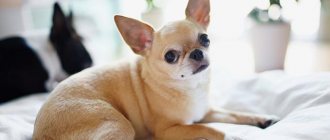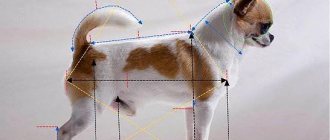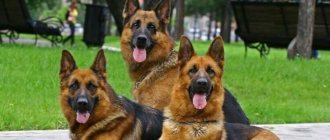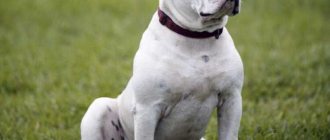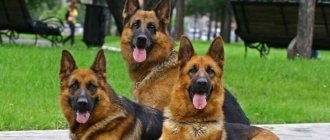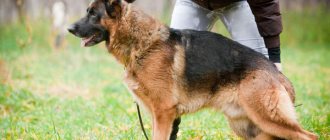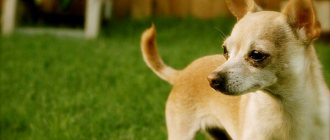Chihuahuas are dogs famous for their small size and light weight.
Due to the fact that this breed has several varieties that differ from each other in growth, all Chihuahuas grow differently.
What should a Chihuahua puppy weigh, depending on his age, how many months will he grow up to, and how much will he weigh when he grows up? And what should you do if, despite seemingly good care and proper feeding, your Chihuahua is not gaining weight well?
General appearance of the breed
All representatives of the Chihuahua breed are very small animals. This mini breed has an elegant appearance as well as a compact body. It is worth noting that such an indicator as the height at the withers corresponds to the weight of the pet.
Dogs of this breed are distinguished by the fact that the tail is always curled in a semi-ring. At the same time, he must look towards the lower back. The main distinguishing feature of this mini-breed is the special structure of the skull. A small gap forms between its bones, called a fontanel. It almost never completely overgrows. However, in addition to appearance, the Chihuahua has a certain breed standard.
Brief breed historical information
The breed first came to attention in the mid-19th century in the Mexican state of Chihuahua .
. Chihuahua), after which it is named.
There is an opinion that the ancestors of the modern Chihuahua are ancient small dogs of the Techichi breed, who lived and domesticated during the existence of ancient peoples: the Toltecs, Aztecs and Mayans.
This is evidenced by archaeological finds found throughout Mexico in the form of figurines depicting a small dog, similar in appearance to a modern Chihuahua. Historical examples date from the 9th century AD.
Techichi was a sacred animal, sacrificed to the gods, and served as food and a small pet for ancient Indian tribes. Read more in the article: history of the Chihuahua breed.
The Chihuahua first appeared at the American Dog Show in 1904 in Philadelphia. The representative of the breed was a smooth-haired female named Midget, acquired on the Mexican border by Mr. Reiner.
In 1923, the National Chihuahua Club was founded and the first breed standard was developed, which included only the smooth-haired type.
In the 1930s, Texas breeders developed the longhaired variety.
In 1954, the Chihuahua standard was revised to include representatives of both species (smooth-haired and long-haired). Subsequently it was adopted by the RKF (Russian Cynological Federation).
Since 2010, no changes or additions have been made to the official document.
Compliance of a Chihuahua dog with the standard is mandatory if the owner plans to:
- participate in breed dog shows;
- engage in breeding work to breed purebred puppies with a pedigree;
- become a member of the NCP (National Breed Club).
Based on the criteria below, the judges determine the dog’s compliance with international standards for the Chihuahua breed and decide on the admission of a potential participant to participate in the exhibition.
A dog's compliance with the generally accepted standard indicates its purebred origin. Otherwise, an exterior class is assigned according to the degree of the defect: “breed” or “pet”.
Standard sizes
One of the most important parameters of the standard is the size of the dog. Animals reach their maximum size before the age of 12 months. Most often, pets grow up to 6 months, and then only gain weight. Males weigh about 1.3–2.7 kg, and females – 1.5–2.7 kg. However, the weight of the largest representative reached 6 kg!
The standard does not precisely specify the height of an adult dog. Usually this parameter varies over a fairly wide range - from 15 to 23 cm at the withers. Whatever the size of the Chihuahua, they still do not go beyond the range established in the standard. The most popular are the short Chihuahuas. Height depends on the breed variety.
What is the table for?
Pregnancy of a Chihuahua by day and childbirth in a dog
A puppy height and weight gain chart is essential for all owners of small Chihuahuas. It helps to find out about existing problems in a timely manner, understand whether the dog is developing correctly, and, if necessary, contact a veterinarian.
The table contains important data about the weight and height of the pet in each month of its life. If your dog quickly gained weight and then suddenly lost weight, do not panic; you can always compare real data and information from the table. Sometimes losing weight or gaining weight at certain times in a puppy's life is normal. A small dog doesn't move much, so it gains weight better. Having learned to stand on his feet normally, and then to run, the puppy quickly gets rid of extra pounds.
Official data helps the breeder decide which category the puppy belongs to, whether it belongs to:
- standard line (adults weigh from 2.3 to 3 kg);
- small standard (1.8-2.3 kg);
- mini dogs (1.5-1.8 kg);
- super miri line (0.5-1.5 kg).
If there is a need, then, based on the data obtained, they try to correct the puppy’s weight (feed more or less, walk more often).
The puppy’s weight needs to be monitored using a special table.
What should the proportions be?
In addition to size, the standard for a given breed determines the proportions of the animal's body. The height at the withers should be slightly less than the length of the body. Males have an almost square body shape, while females have a more elongated body shape (due to the need to bear offspring). Such proportions are observed in both small and larger representatives.
We recommend this article:
How to choose a healthy Chihuahua puppy
Table of dog weight and height at the withers
Chihuahua dog weight chart by month is an important tool that all Chihuahua breeders use.
| Age, month | Weight according to line, g | |||||||
| Super mini | Height, cm | Mini | Height, cm | Small standard | Height, cm | Standard | Height, cm | |
| Newborn | 70-80 | 14-15 | 90-120 | 14-17 | 125-130 | 17-19 | 145-170 | 18-23 |
| 1 | 200-225 | 230-350 | 450-490 | 500-650 | ||||
| 2 | 315-370 | 455-610 | 680-765 | 825-1050 | ||||
| 3 | 425-540 | 625-855 | 940-1050 | 1165-1400 | ||||
| 4 | 570-710 | 855-1110 | 1250-1390 | 1530-1820 | ||||
| 5 | 680-885 | 995-1300 | 1480-1645 | 1815-2150 | ||||
| 6 | 740-945 | 1110-1450 | 1645-1845 | 2015-2410 | ||||
| 6,5 | 765-970 | 1150-1510 | 1710-1900 | 2100-2500 | ||||
| 12 | 1000-1200 | 1400-1900 | 2100-2300 | 2500-3000 |
For your information! To determine the weight of a dog, a three-month-old puppy can be weighed and the result obtained multiplied by 2. These will be the parameters of an adult.
How to use the table
Every 30 days the puppy is weighed and measured at the withers. If its parameters fall significantly short of the specified standard, contact a specialist. There is no reason to appeal if the parameters deviate by a few grams down or up.
Head standard
Chihuahuas are distinguished by a large skull, which is apple-shaped. In this case, the height and width of the skull are equal. There are also pronounced brow ridges. The convexity of the forehead noticeably extends to the muzzle. The animal's head is wide at the base, but narrows towards the nose. The cheekbones on the muzzle are poorly defined and rounded. The lips fit tightly and are characterized by a tense structure. At the same time, they must cover the teeth completely.
The nose is small and slightly upturned. The RKF standard allows for any color of the nose. The main thing is that it matches the color of the coat. The eyes of animals are expressive, round and large. On the face they are widely spaced. There is a deep groove between them. The look is slightly sly. The eye color is dark and goes well with the coat color. However, according to the standard, light eye color is also allowed. Along it, the eyes and nose should form an equilateral triangle.
The Chihuahua's bite is straight, but can also be scissor-shaped. The defect will be an overshot or undershot. As for teeth, their number is not regulated. It may be incomplete. The ears are located quite high. They are wide at the base, but taper towards the apex. The tip is rounded. When at rest, the ears hang at an angle of approximately 45 degrees. When the dog is excited, they rise straight up. At the same time, the distance between them decreases. The difference in ears between different representatives of this breed is minimal.
The head is located on an elongated neck, on top of which there is a characteristic small-sized bend. There is no suspension. Males have a more powerful neck compared to females.
What to do if your weight is below normal?
First of all, this issue worries the owners of Chihuahua girls, since bitches whose weight is 2 kg or more are allowed for breeding.
But the owners of boys of this breed may also be concerned that the pet does not live up to the standard, while some of them are worried that the male may be disqualified at the exhibition, while others are worried because standard and large Chihuahuas have better health than their smaller mini and, especially, micro relatives.
What to do if the Chihuahua’s weight does not reach the standard requirements?
First, you need to find out what the lack of weight or height may be associated with. If this is a hereditary problem, for example, if the puppy belongs to a line whose representatives mature late, then you just need to wait until the pet is fully grown and fully grown.
If a Chihuahua puppy does not grow well due to improper rearing or due to an illness suffered at an early age, then you need to consult a veterinarian and ask him to prescribe the most suitable vitamin and mineral supplements or other medications for your pet.
Sometimes it makes sense to reconsider your pet’s diet or living conditions.
So, for example, for a Chihuahua that eats natural food, it is recommended to increase the amount of protein products in the diet, and it would be better not meat, but fermented milk. The ideal option here is cottage cheese, because, in addition to protein, it also contains calcium, which is also necessary for the proper growth of the dog.
If the dog eats ready-made food, then you need to try to switch it to a higher quality food, for example, from premium to super-premium class.
Longer and more active walks with your Chihuahua will also be useful, although you need to make sure that the pet does not become overtired.
IMPORTANT!
It should be remembered that the weight and size of puppies and adult dogs, which is given in the tables, is average, and that not all dogs, due to their individual characteristics, will have a real weight that corresponds to it.
Ideal case
The body of this breed must be harmoniously and firmly built. A slight elongation is not considered a defect. The back is strong and level. It goes into the muscular lower back. The croup itself is wide with a slight slope. The chest is quite wide with rounded ribs. The chest itself is also rounded to the elbow of the front legs, forming a characteristic barrel-shaped shape with a tucked belly.
Similar article: Description and behavioral characteristics of the miniature Chihuahua breed
There are two types of housing:
- dir – elegant or “deer-like”;
- cobby - heavy.
The tail of all Chihuahuas is of average length and is set high. It is thick at the base, tapering towards the apex. A Chihuahua without a tail is considered a defect.
Character
In general, we can say that the character of the Chihuahua is calm, but there are situations in which a cute dog turns into an aggressive animal. For example, it has been observed that sneezes are intolerant of representatives of other dog breeds. A small dog can easily attack a large shepherd. This can lead to injury and even death to the miniature daredevil. It is interesting that this dog behaves peacefully with other sneezes and enjoys playing with its own kind.
The sneeze is attached to the owner, the greatest happiness for him is to be nearby, to observe what he is doing. For older people, Chihuahuas are a real find. A dog can calmly lie on the lap of its beloved owner for hours. It is better not to leave him with small children; children may accidentally injure the dog, and the dog, in turn, may bite the child in self-defense.
Adults prefer to spend time in peace and quiet. Puppies, on the contrary, are ready to run, jump, and play games with similar pets or with household members for days. When you go on a trip, you can without a doubt take your Chihuahua with you. The dog is able to easily endure travel, sitting comfortably in the arms of the owner or sitting in a special carrier bag.
The sneeze is suspicious of strangers, so it makes a wonderful watchman. Possessing a quick reaction and good hearing, dogs of this breed are able to recognize the owner’s car by alarm and recognize not only his voice, but also the sound of footsteps. It is easy to recognize who is behind the door by sneezing.
For its love and devotion, a pet will require the same attitude towards itself. He cannot stand loneliness; if left alone, he will bark loudly in protest. We can say that the dog is too affectionate. She will come up with any ways to draw the attention of household members to herself. If you cannot devote enough time to a small pet, buy not one, but two sneezes or a representative of a different breed.
Miniature Breed Limbs
A characteristic feature of the Chihuahua is its strong and stable front legs, parallel to each other.
If you can notice a difference between them, then this is a defect. Looking at the animal from the side, it becomes noticeable that the metacarpus is slightly oblique and elastic. The elbows should be pressed tightly against the body.
The hind legs are also well developed. Characterized by a vertical posture with a parallel arrangement. The limbs have soft paw pads. Long fingers with slightly elongated claws.
What puppies look like
Puppies are very different from adults, but they grow quickly, and at the age of three months they already resemble ordinary Chihuahuas.
They are born very small . Due to the size of the mother, complications often occur during childbirth, when the help of a specialist cannot be avoided.
Dogs are born blind and very tiny. They can only crawl in order to find mother's milk.
At birth, the color of the babies is already visible, and in most cases it does not change, but remains . The puppies' ears are not yet erect, they are pressed to the head, the tail is short and thin, pressed to the body.
The dogs still have a pink nose, their claws are small and soft, they cannot yet be scratched - this is necessary so that they can stimulate the supply of milk while eating.
The puppies don't have whiskers yet, they will appear later.
Coat
The Chihuahua's coat can be either short or long. Dogs with short hair have soft hair. The fur fits very tightly to the body. If there is an undercoat, the hair is longer. This is usually clearly visible on the tail and neck. Usually short hair is observed on the ears and head. In the throat area it is almost absent.
Long-haired representatives have a smooth coat. It is soft and thin. Small waves may form. The longest hair is located on the paws, neck, ears, chest and tail.
Nutrition
Decorative lap dogs in most cases have a sweet tooth; they love to bite and beg for food from their owners when they eat. You should not follow the lead of gluttonous pets. Their diet must be controlled. Poor nutrition can lead to health problems such as obesity. The stomach may also suffer due to harmful foods. To prevent such troubles from happening, follow the following rules for feeding your Chihuahua:
- Food must be fresh.
- If food is prepared for several days, store it in the refrigerator.
- Food should be at room temperature.
- Portions should be the same.
- If there is food left in the bowl, it should be removed before the next feeding, giving your pet 20 minutes to eat.
- If a dog refuses a certain type of food, you cannot indulge such whims. When your pet gets hungry, he eats everything and will no longer be capricious.
If you decide to feed your dog natural food, check out the lists below. These recommendations will help you create the right diet for your pet.
Products that are healthy for dogs:
- Cereals - porridge should be well boiled and made from rice, millet or buckwheat groats.
- Meat – lean meats should be fed every day. By-products or boiled fish can replace meat twice a week.
- Vegetables – recommended boiled or stewed.
- Eggs – once a week, boiled.
- Fermented milk products – kefir, low-fat cottage cheese, fermented baked milk, bio-yogurt.
- Fruits – it is preferable to feed bananas and apples in fresh chopped form.
Prohibited products:
- Fatty meats put a lot of stress on the liver.
- Legumes – provoke intestinal spasms and bloating.
- Sausages contain a high content of additives harmful to dogs.
- Sweets lead to excessive tearing, indigestion and tooth decay.
- Fresh cabbage causes bloating.
Not every dog owner can find the time to prepare natural food for their pet. In this case, he is transferred to dry food. This method of feeding has its advantages: it does not require much time for preparation, contains all the vitamins and microelements, and is balanced.
You should only buy dry food from trusted outlets that specialize in selling professional food. If your dog has health problems, your veterinarian will recommend a special medicated food. In other cases, you should purchase super premium food.
Clean, cool water should always be available. It is recommended to install containers for food and water in special stands, so that the pet will not be able to turn over or move the filled dishes.
Main disadvantages
Any deviation from the accepted standard is a serious drawback. These include:
- flat or narrow skull;
- long and large muzzle;
- strong protrusion of the eyes or their small size;
- pointed or floppy ears;
- small neck;
- concave as well as curved spine;
- elongated body;
- misaligned jaw;
- small breast volume;
- completely thinning hair;
- sloping croup;
- narrow set of paws, as well as their curvature, etc.
Similar article: How to make a house for a Chihuahua with your own hands
The presence of the above deviations affects the cost of the animal.
Main types of colors
The most common colors are:
- Ginger . A gradation from red to light red fur is acceptable. It is almost impossible to meet a completely red dog. It goes with other colors. These may be white spots. “Red sable” suggests hairs with dark tips (shown in the picture).
- Black. All-black Chihuahuas are just as rare as red ones. Most often, a dog is born black and tan. There are also black Chihuahuas with white markings on the chest and toes. Black and tan Chihuahuas with milky spots on the chest, legs and tip of the tail are popular.
Rare colors of Chihuahua (shown in the photo):
- Chocolate. Brown dog with a red tint. Dogs come in pure color, or also with small light markings. Various shades of chocolate, sable, and chocolate tricolor are allowed.
- White. Found only in its pure form. There should be no large marks or stains on the fur.
- Brindle . This color allows for a large number of variations. For a Chihuahua, this is fawn in any gradation, thick black. Different types of patterns on wool are acceptable.
- Lilac. A very beautiful color that is quite rare. The shade can be of any saturation. When the color is so light that it looks like pink, it is called “Isabella.” A purple tricolor is allowed.
- Blue. The blue Chihuahua can be dark, almost gray, or smoky. White patches on wool and tricolor are allowed.
Prohibited color of Chihuahua:
- Merle, or marble. The wool looks as if it is unevenly dyed black, dark gray or beige, which is why the marbled effect is created. The eye color of these dogs is watery blue. Puppies with this color are often born blind, deaf, or without eyes or ears at all. Often offspring with such a gene die in the womb or at birth. If the individual grows, its sterility may be revealed.
Experts believe that this gene appeared in Chihuahuas from crossing with dachshunds, which are carriers, since it does not harm their health.
Breed defects
The main defects of the breed include:
- light build;
- absence of a tail;
- the presence of bald patches on the body;
- heavy weight (from 3 kg);
- long ears and tail;
- extended body;
- in males - underdeveloped testes or not descended into the scrotum, absence of testicles.
Knowing what parameters in the Russian standard are typical for a Chihuahua, you can quickly determine the purebred nature of the purchased pet. The above parameters of the breed standard will help you choose the future winner of the exhibitions.
We recommend this article:
Who is better and who to choose: Chihuahua or Toy Terrier
Unusual Chihuahuas
Sometimes genes adjust the coat color of dogs in very funny ways, resulting in funny and unusual Chihuahuas. This is a Chihuahua, popular on the Internet, with eyebrows similar to human ones.
It is not uncommon for Chihuahua puppies with spots on their fur that take on the shape of a heart, and this feature is often inherited from one of the parents .
The owner of a Chihuahua shared a photo of his pet, where one of the spots resembled the continent of Eurasia.
How to choose a pet
Do not buy a puppy on the market, it is better to contact a professional breeder . Before doing this, find people who have already dealt with it, ask their opinion. This way you can know in advance what to expect when you go pick up your puppy.
IMPORTANT!
Pay attention to the conditions in which the dogs are kept, look at what food the puppies eat.
You should have no doubt that the puppy before you was in good hands.
Ask the breeder for the dog's passport, ask how many puppies were in the litter - there should be no more than five.
Also, when purchasing, you should pay attention to:
- Appearance of a puppy. It should not look sick or dirty. Shouldn't be either thin or fat. Also check whether his appearance meets the standard, there are no deviations, lameness, or lethargy. Check your nose - it should be cold and slightly moist. There should be no discharge in the eyes and ears. The ears should not lie down during the game, they should be tense. The coat should be soft and shiny. Check to see if your puppy has skin rashes, ringworm, fleas or ticks. The upper jaw should completely cover the lower jaw.
- Chihuahua behavior. Observe your puppy while he plays. He should be active, cheerful, and not aggressive. Talk to him yourself, see if there is any excessive nervousness or fear in him. Chihuahuas are always curious, so if he boldly comes to sniff your hands, it's a good sign. Wait until lunch time. If the puppy eats with appetite and eats the entire bowl, that’s also good.
